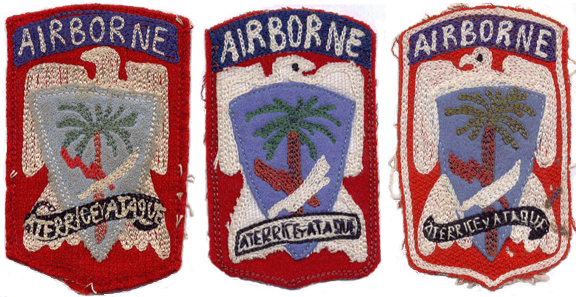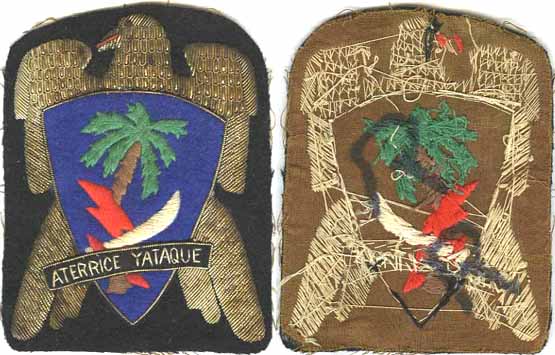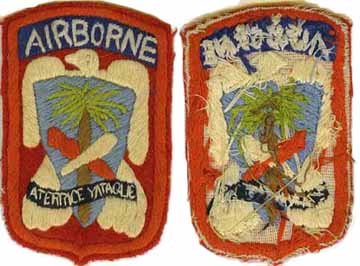|
|
Insignia of the 551st Parachute Infantry Battalion by Les Hughes © by author 2007 |
|
|
|
The 551st PIB adopted an unofficial insigne that
depicts an eagle on which is superimposed a shield bearing a palm tree
and a machete. Below the shield is the motto aterrice y ataque,
Spanish for land and attack! This design exits both as a jacket
patch and as sleeve patches. The
eagle of the jacket patches is executed in bullion, while versions of
the sleeve patch exist with the eagle in cloth and one version with the
eagle in bullion. These patches are among the rarest of WWII airborne
insignia.
Two examples of the jacket patch of the 551st. The author believes they were most likely made in Italy. When I began seeking information (circa 1983) among veterans
of the 551st regarding the history of the battalion's
insignia, I was struck by how little information my first contacts could
provide. The problem would
be solved, I thought, by contacting more veterans.
I subsequently telephoned or wrote to all members of the 551st
Parachute Infantry Association. This provided more information, but the
information was sometimes contradictory. Some questions remain
unanswered, and probably always will.
I made a crucial mistake by not pursuing the subject in
greater depth with Col. Evans during that conversation. But my research
was just beginning and some questions did not arise until later;
besides, I planned to contact him again.
But I was unable to do so: Col. Evans passed away one week after
returning from the reunion in France.
In retrospect, I believe he was the individual best able to
resolve some of the questions that remain. Two years after the publication of my 1985 article, I located Vincent Artz and asked him about the origin of the patch design. He wrote: "During my service in the army, I did some sketching. In Panama this activity came to the attention of Colonel Joerg. Sometime during the month of May 1943, he approached me about his desire to have a 'battle insignia' design. He asked me whether I would create an insignia for the 551st and I naturally consented to undertake the task. In the process of events, Jim Evans became involved in the activity. At the time, I know he was serving in Battalion Headquarters, and I think he was the Adjutant. During the design, Evans and I had a number of conversations about the elements contained in the design and the general form. Jim never put a pencil or brush to paper in relation to this insignia but he certainly was helpful during the primary development stages. There really isn't very much originality in the design. The battle cry 'aterrice y ataque' translates loosely from the Spanish to English, 'land and attack'... or at least that is what we wanted to do."1 Artz, who since the war had become a successful artist, still had his drawing of the design, and it was dated June 1943, when the unit was in Panama.
(L. to R.) Lieutenants R. Workman, P. Hand, and B. Chisholm, and Pvt. A. Vassily somewhere in S. France. The
information I received from other members of the battalion
muddled rather than clarified the origin of the patch design. Dan Morgan: "We only had one patch and that was the
result of a contest which our Colonel (Joerg) held while we were in
Panama, at Fort Kobbe. I
was there and remember it well—in fact, I submitted an entry myself
(as did a lot of other guys) but it wasn't accepted.
... A very few of us still have the originals which were made for
us in Panama after the winner of the contest was announced.
Alas, I not recall who was the winner—I think he got a
three-day pass.”2 Lou
Waters (letter of 14 November 1984): “...the man who designed the
shoulder patch for the 551st parachute infantry battalion was
Walter L. Raftery, a private in A Company.
We were at Camp Mackall, N.C.... This was sometime in the early
fall of the year 1943. A notice was posted on all company bulletin
boards to the effect that a unit insignia was being considered, and
everyone was invited to submit their idea... There was a proviso that
any drawing or sketch submitted should reflect our status as a parachute
infantry assault force and also our recent experiences in the jungles of
Panama. Raftery won
the contest and was awarded a three-day pass... The slogan on the scroll
was suggested by our battalion commander. Having some talent at copying
and enlarging, I was given the job of painting the insignia on a section
of wall outside the combined officers mess at Mackall.
Every unit that passed through Mackall on its way to the battle
zones left a similar painting of their insignia on the wall of that mess
hall, and the place took on the appearance of the dining hall in a
medieval feudal baron's castle.”3 Walter Raftery is one of the many members of the 551st
whose fate is unknown. Lou Waters believed he was killed during the
Battle of the Bulge, but in 2006 the author found him listed on the
battalion’s Bulge casualty reports as having been lightly injured in
action and returned to duty on 19 January 1945.
Dan Morgan: “Lou Waters's letter reached me today... on the basis of what Lou has written, I suspect the patch that I called authentic was made up at Mackall (with "AIRBORNE" on it). I'm beginning to wonder if I'm right in thinking that we had that contest down in Panama, and that a patch was available to the enlisted men that time. Lou remembers a contest at Mackall—and he was involved in painting are insignia at the officers mess. I cannot argue that point. I like what Lou says in his letter—I don't find much to argue over, except that I still have the feeling that we did have a contest in Panama.”4 [Dan's comments indicate that it is the sleeve patch, not the jacket patch, to which he is referring.] Richard Mascuch: “The insignia was first made into a patch in Italy, somewhere around Naples. Among the papers I went thru yesterday were copies of Hook-Up, the battalion newspaper—some from the Canal Zone and some from camp Mackall in 1944. None show or mention that insignia, nor was it shown on the masthead.”5 Mr. Mascuch’s belief that the patches were made in Italy is interesting, as some collectors believe the 551st patches are similar in construction to others made in Italy. But his conclusion that the patch design was not manifest in the battalion until Italy is incorrect: the design appeared while the unit was at Mackall on the back of the battalion’s 1943 Christmas menu and on the masthead of the 23 February 1944 issue of Hook-Up (see images). About ten years after my article appeared, long after I had concluded my research into the origin of the patch of the 551st, I was contacted by a collector who had acquired a number of items from the family of 551st veteran Jack Rolland. Among the items was an ink drawing of the 551st patch that constitutes a puzzling footnote to its history. Patch design of Vincent Artz (left) and one attributed to Ivah Rolland. The drawing, which I believe is in color (I was supplied with a black and white photocopy) is nearly identical to that of Artz, differing only in minor details (the lettering on the scroll is distinctive and essentially identical in both drawings—see images). To see how similar the drawings are, I superimposed, face to face (so that the eagles face the same way), photocopies of each, and then held them up to a light source. The drawings superimposed (except for the motto scrolls, which were reversed), which indicates that one was derived directly from the other. There are a number of handwritten notations on the lower part of the Rolland drawing, notations related to the symbolism and the colors employed in the design. At the very bottom, this handwritten notation appears: "Insignia de una Battalion des Parakaita." Intended, apparently, to be Spanish but written by someone not fluent in the language (it should read, insignias de un Batallón de Paracaidistas), this notation places the drawing in Panama, as does the date on the Artz drawing. The intriguing aspect of the drawing is the notation that has been typed
over (and perhaps long after) the handwritten notation: "This
design made by Ivah Rolland, mother of Jack F. Rolland." Despite
this notation, I believed that the comments of Jim Evans and Vincent
Artz most accurately reflect the origin of the unit's patch design. But
it was not until I received information from Gary E. Banas, who came
into possession of a group of Jack Rolland’s artifacts, including this
drawing, some of Rolland’s wartime correspondence with his mother, and
several photos, that the mystery was largely solved.
Where were the unit's patches made?
Here again there is uncertainty.
While several veterans believed they might have received their patches while in Panama,
only two were certain of it: Tims
Three examples of 551st sleeve insignia. The author believes they may have been made in Panama. So, what is one to conclude? My belief is that the jacket patches were made in
Italy. This is based on
their construction, which is consistent with the patches of other units
known to have been made in Italy, and the absence of their appearance in
photographs of unit personnel taken in Panama or at Camp Mackall. Col.
Evans provided a photograph of himself wearing the patch on his field
jacket. I was unable to asked him if he knew where the photo, a studio
pose, had been taken. But I
suspect that it had been taken in Italy because above the patch is an
oval (and not the distinctive 551st oval) on which is
embroidered the parachute qualification wing, which is similar to other
oval/wing combinations I have seen in the hands of airborne veterans of
the Italian campaign. The sleeve patches, on the other hand, may have
been made in Panama. Again,
this is based on their construction, which is relatively crude.
The battalion's jump wing oval backings are of two-piece felt construction. The unit had its own jump wing oval backing of gold on purple.
These are A distinctive unit insignia (DUI) exists for the 551st,
but it was made (in Europe) after the war—long after the unit had been
disbanded—and has no official connection to the battalion.
While the above quote indicates that 10 of the collar insignia were made at that time, there is no way to rule out others having been made later during the war. One example of the collar insignia, attributed to Mr. Fairlamb, was auctioned on eBay circa 2004. Sometime afterwards, I had an opportunity to examine his Ike jacket, and it still bore two, just as the above photo shows. Were all three his, or just the two on his Ike jacket? As the construction of the collar insignia is fairly simple, it is reasonable to expect to encounter copies. I am aware of one example of the insignia that employs a parachute taken from a wing made by the British firm of Firmin. The path the battalion took from the States to the Ardennes argues against the men having had access to British-made US jump wings, but stranger things have happened. Reproductions/FakesSuperb copies of the jacket patch exist—I have received
reports of some having sold for significant sums. The fronts of these
copies exhibit high fidelity to genuine patches; the backs do not. That
is not to say that the fakers have ignored the backs: care has been
taken to make the backs appear reasonable, both in terms of construction
and apparent age. And as few collectors have had an opportunity to
examine a genuine example of the 551st jacket patch, they
have no basis for judging the backs other than to assess whether what
they find there appears reasonable. (Were I to show the backs of genuine
patches, it would simply ensure high-fidelity fronts and backs in
the next generation of fakes.) I first encountered one of these copies in the late-1990s when a veteran of the 551st, whom I knew well, sent me photos of one he had been given by a collector in Belgium. (One of the reasons I knew the piece was a copy was because I knew that the collector would never have parted with it had it been genuine.) Sometime after the death of the veteran, several years later, I contacted his family and asked if they still had the patch. They searched but were unable to find it. I wonder to this day if the patch may have found its way into the hands of a collector, and, as its source was a veteran of the 551st, it will forever be genuine.
Reproduction of 551st jacket patch. Illustrated above is an example of a copy that was part of a collection purchased by a dealer whose expertise allowed him to identify it as a reproduction and whose integrity compelled him to mark it and sell it as such. But he cannot control how subsequent owners choose to use the patch, and the potential exists that this patch could find its way onto, say, an A-2 jacket, and the combination be sold as genuine. After all, what collector is going to remove a rare patch from an A-2 just to check its back? Some years ago, a collector sent me a 551st jacket patch that he was considering purchasing, and he asked my opinion of it. The front of the patch was quite well done, but the back differed significantly from the three genuine examples I had. One thing that bothered me about the front was that the bullion had a slight gold cast to it when viewed in the sunlight, whereas bullion of the originals are silver. I subsequently examined the bullion under a stereo microscope, and, using a needle probe, I was able to chip pieces of a material off the surfaces of individual strands of the bullion, exposing a bright, metallic surface underneath. I concluded that the bullion had been artificially aged by coating it with a lacquer-like substance that, when dry, gave the appearance of tarnish. It appeared, too, that an effort had been made to give the back an appearance of age, perhaps by rubbing it with sand or allowing it to collect dust for some time and then rubbing the dust in.
Reproduction of 551st sleeve patch. While copies of the sleeve patches exist, none that I have
seen (as of mid-2007) were as well done (in terms of fidelity to genuine
patches) as the jacket patches. Still, they fooled collectors who
operated beyond their expertise. The one illustrated above sold for over
$500. (As it is impossible to educate the collecting community through
articles such as this without at the same time educating those who prey
on the collecting community, higher fidelity copies of the sleeve
patches will probably appear as a result of the information presented
here.) A US-made jacket patch, on white wool, exists.
While this version, illustrated above, is collectible, it was not
made for the unit. How does one protect one’s self when acquiring a 551st
patch? First and foremost
by recognizing the fact there are so few genuine 551st
patches in existence that the probability of your encountering one for
sale is almost nil. (This applies equally to jacket and to sleeve
patches.) For those unwilling to accept this harsh truth, these
practical tips may be of value. If you encounter a genuine 551st
patch for sale, the seller will either recognize what he has or he will
not. If he does, then he will want an arm and a leg for the patch. That
being the case, beware of 551st patches that are offered for
less. For example, I noted
above that a 551st sleeve patch sold for between $500 and
$600. That would have been a bargain price had the patch been genuine,
and it should have raised suspicions. Finally, be wary of any 551st
insignia that do not possess solid, verifiable provenance. References1. Letter dated 2 November 1987 2. Letter dated 6 November 1984. 3. Letter dated 14 November 1984. 4. Letter dated 26 November 1984. 5. Letter dated 19 October 1984. 6. Gary E. Banas, “A Paratrooper’s Story.” Trading Post, April/June 2001. 7. Dan Morgan, The Left Corner of My Heart (Alder Enterprises, Wauconda, WA, 1984), 326-327. Sgt. Fairlamb's trip to Paris would have had to occur during the period 8 to 16 December 1944, when the battalion was headquartered near Laon. Few of the men - probably no more than a dozen - made it to Paris before the German breakout in the Ardennes necessitated canceling all passes.
|

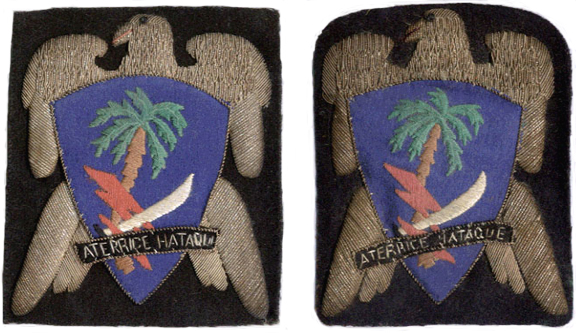
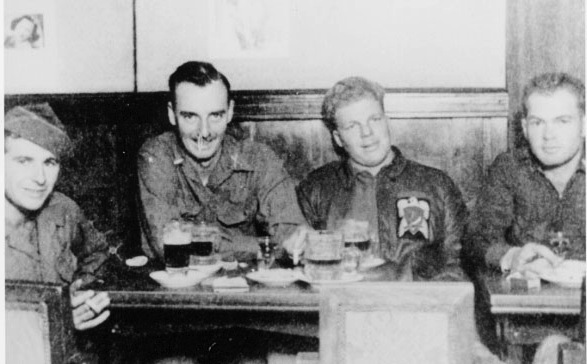
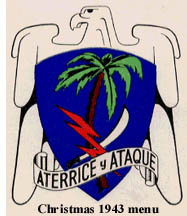
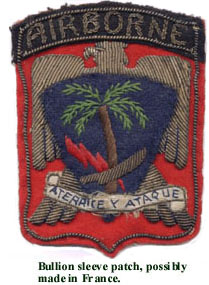 Quinn (a jacket patch) and
Frank Yungman (a sleeve patch).
Quinn (a jacket patch) and
Frank Yungman (a sleeve patch).